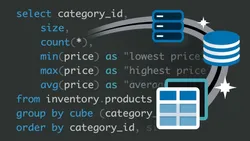
Batting Location Charts with Vagrant and MySQL 
Vagrant and MySQL can be used together to create batting location charts from large data sets using R. This provides an efficient way to visualize and analyze data. ▼
ADVERTISEMENT
Course Feature
![]() Cost:
Cost:
Free
![]() Provider:
Provider:
Udemy
![]() Certificate:
Certificate:
No Information
![]() Language:
Language:
English
![]() Start Date:
Start Date:
Self Paced
Course Overview
❗The content presented here is sourced directly from Udemy platform. For comprehensive course details, including enrollment information, simply click on the 'Go to class' link on our website.
Updated in [April 29th, 2023]
This course provides an overview of how to use Vagrant and MySQL to create batting location charts. Students will learn how to install MySQL on an Ubuntu system and perform basic administration activities. They will also learn how to use the vi program to modify the MySQL configuration file. Additionally, students will learn how to use Vagrant to forward ports and scrape PITCHf/x hit location data. Finally, they will learn how to use R to query MySQL.
[Applications]
After completing this course, students can apply their knowledge to create batting location charts with Vagrant and MySQL. They can use Vagrant to forward ports and scrape PITCHf/x hit location data. Additionally, they can use MySQL to perform basic administration activities and use R to query MySQL. Finally, they can use the vi program to modify the MySQL configuration file.
[Career Paths]
1. Database Administrator: Database Administrators are responsible for the installation, configuration, maintenance, and security of databases. They must ensure that the databases are running efficiently and securely, and that they are backed up regularly. With the increasing demand for data-driven decision making, the demand for Database Administrators is expected to grow significantly in the coming years.
2. Data Scientist: Data Scientists are responsible for analyzing large amounts of data and extracting meaningful insights from it. They use a variety of tools and techniques to uncover patterns and trends in data, and then use those insights to inform decisions. With the increasing demand for data-driven decision making, the demand for Data Scientists is expected to grow significantly in the coming years.
3. DevOps Engineer: DevOps Engineers are responsible for automating the deployment and management of applications and services. They use a variety of tools and techniques to ensure that applications and services are running efficiently and securely. With the increasing demand for automation and cloud-based services, the demand for DevOps Engineers is expected to grow significantly in the coming years.
4. Software Engineer: Software Engineers are responsible for designing, developing, and maintaining software applications. They use a variety of tools and techniques to ensure that applications are running efficiently and securely. With the increasing demand for software applications, the demand for Software Engineers is expected to grow significantly in the coming years.
[Education Paths]
1. Bachelor of Science in Computer Science: This degree path focuses on the fundamentals of computer science, such as programming, software engineering, and computer architecture. It also covers topics such as artificial intelligence, machine learning, and data science. This degree path is becoming increasingly popular as technology advances and more businesses rely on computer systems.
2. Bachelor of Science in Information Technology: This degree path focuses on the application of technology to solve business problems. It covers topics such as database management, network security, and web development. This degree path is becoming increasingly popular as businesses rely more heavily on technology to manage their operations.
3. Bachelor of Science in Data Science: This degree path focuses on the analysis of large datasets and the development of algorithms to extract insights from them. It covers topics such as machine learning, data mining, and predictive analytics. This degree path is becoming increasingly popular as businesses rely more heavily on data-driven decision making.
4. Master of Science in Artificial Intelligence: This degree path focuses on the development of algorithms and systems that can learn from data and make decisions. It covers topics such as natural language processing, computer vision, and robotics. This degree path is becoming increasingly popular as businesses rely more heavily on artificial intelligence to automate processes and make decisions.
Course Syllabus
Creating the Virtual Machine
Installing MySQL
Logging in and out of MySQL
Creating a User
Granting Privileges
Changing the Bind Address
Forwarding the Port
Loading the R Packages
Scraping the Data
Investigating the Tables
Deciding What Information We Want
Making the Query
Modifying the Data Frame
Beginning the Plot
Enhancing the Plot
Getting More Data
Putting It All Together
Pros & Cons

Clear explanations

Good examples and problems

Connect MySQL to RStudio

Large font

Well explained

Short course

No example code

Not enough technical explanations

Not useful for Python users
Course Provider

Provider Udemy's Stats at AZClass
Discussion and Reviews
0.0 (Based on 0 reviews)
Explore Similar Online Courses

Cryptocurrency Trading Explained

Design and Make Brass Jewelry from Scratch

RDBMS PostgreSQL

Intro To PostgreSQL Databases With PgAdmin For Beginners

PostgreSQL: Client Applications

Mastering SQL using Postgresql

Database Design and Basic SQL in PostgreSQL

PostgreSQL: Advanced Queries

Spatial SQL with Postgres : A language for geographers

Learn SQL Using PostgreSQL: From Zero to Hero

PostgreSQL Essential Training


Start your review of Batting Location Charts with Vagrant and MySQL